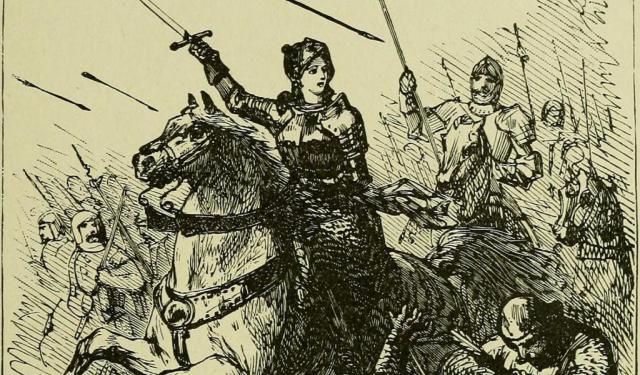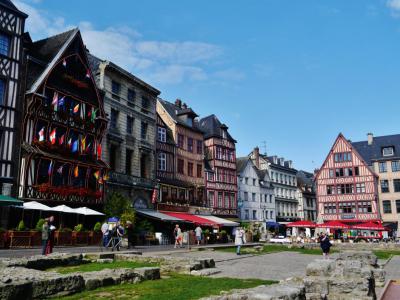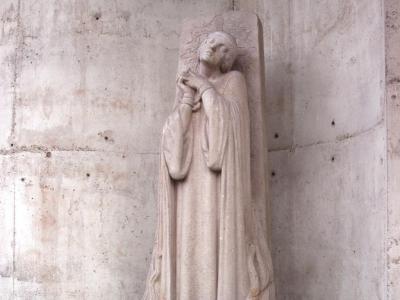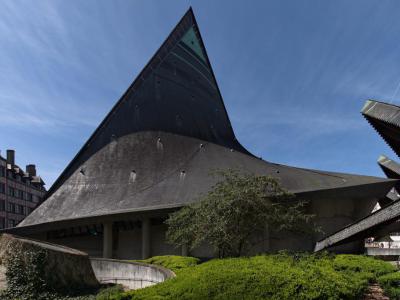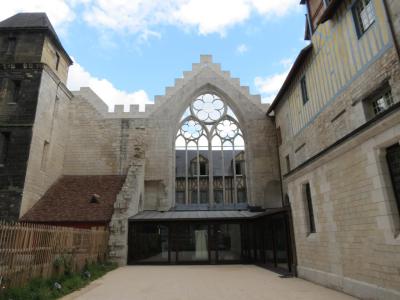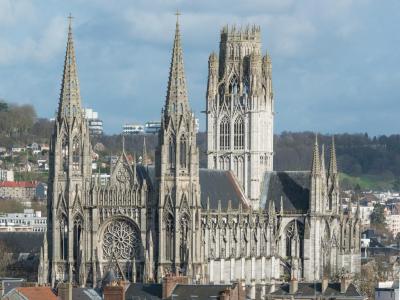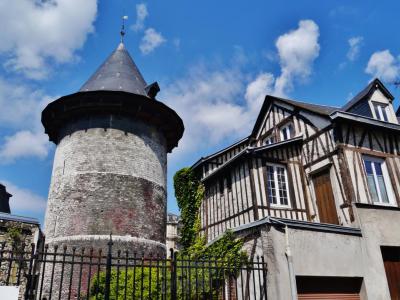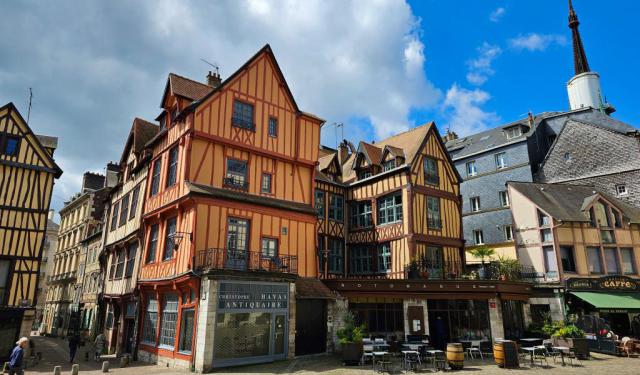Joan of Arc Historical Sites (Self Guided), Rouen
Joan of Arc, a patron saint of France, is honored as a defender of the French nation for her role in the 15th-century siege of Orléans that marked a turning point of the Hundred Years' War between France and England. The memory of Joan is engraved in various heritage sites and urban spaces throughout Rouen, the town in which she met her death.
The historic Old Market Square (Place du Vieux-Marché) in particular holds immense importance in Joan's story, as it was here that she was burned alive at the stake by her English captors. Today, visitors can walk on the same cobblestones where this historic event took place. Adjacent to the square, you'll find a poignant statue commemorating Joan of Arc's final moments.
Church of Saint Joan of Arc: This modern church, constructed in the 1970s, pays homage to the saintly "Maid of Orleans" with its unique architecture and stained glass windows depicting her life.
The Historical Joan of Arc (Historial Jeanne d’Arc) museum is a treasure trove of information about Joan's life and the historical context of her time. It features artifacts, multimedia presentations, and exhibitions that provide a comprehensive understanding of her extraordinary journey.
The cemetery of the Abbey Church of Saint-Ouen (Abbaye Saint-Ouen) is the site of Joan of Arc's abjuration.
Another famous structure is Rouen Castle (Chateau Bouvreuil), whose keep is known as the place, where Joan of Arc was brought to be threatened with torture.
If you wish to experience Joan of Arc's remarkable story, Rouen is the place. The above landmarks provide an opportunity to gain a deeper appreciation for the heroine's enduring legacy. Visit Rouen and be captivated by the spirit of the legendary figure, who transcended gender roles and gained recognition as a savior of France!
The historic Old Market Square (Place du Vieux-Marché) in particular holds immense importance in Joan's story, as it was here that she was burned alive at the stake by her English captors. Today, visitors can walk on the same cobblestones where this historic event took place. Adjacent to the square, you'll find a poignant statue commemorating Joan of Arc's final moments.
Church of Saint Joan of Arc: This modern church, constructed in the 1970s, pays homage to the saintly "Maid of Orleans" with its unique architecture and stained glass windows depicting her life.
The Historical Joan of Arc (Historial Jeanne d’Arc) museum is a treasure trove of information about Joan's life and the historical context of her time. It features artifacts, multimedia presentations, and exhibitions that provide a comprehensive understanding of her extraordinary journey.
The cemetery of the Abbey Church of Saint-Ouen (Abbaye Saint-Ouen) is the site of Joan of Arc's abjuration.
Another famous structure is Rouen Castle (Chateau Bouvreuil), whose keep is known as the place, where Joan of Arc was brought to be threatened with torture.
If you wish to experience Joan of Arc's remarkable story, Rouen is the place. The above landmarks provide an opportunity to gain a deeper appreciation for the heroine's enduring legacy. Visit Rouen and be captivated by the spirit of the legendary figure, who transcended gender roles and gained recognition as a savior of France!
How it works: Download the app "GPSmyCity: Walks in 1K+ Cities" from Apple App Store or Google Play Store to your mobile phone or tablet. The app turns your mobile device into a personal tour guide and its built-in GPS navigation functions guide you from one tour stop to next. The app works offline, so no data plan is needed when traveling abroad.
Joan of Arc Historical Sites Map
Guide Name: Joan of Arc Historical Sites
Guide Location: France » Rouen (See other walking tours in Rouen)
Guide Type: Self-guided Walking Tour (Sightseeing)
# of Attractions: 6
Tour Duration: 1 Hour(s)
Travel Distance: 1.8 Km or 1.1 Miles
Author: DanaOffice
Sight(s) Featured in This Guide:
Guide Location: France » Rouen (See other walking tours in Rouen)
Guide Type: Self-guided Walking Tour (Sightseeing)
# of Attractions: 6
Tour Duration: 1 Hour(s)
Travel Distance: 1.8 Km or 1.1 Miles
Author: DanaOffice
Sight(s) Featured in This Guide:
- Place du Vieux-Marche (Old Market Square)
- Joan at the Stake Statue
- Eglise Sainte-Jeanne-d'Arc (Church of Saint Joan of Arc)
- Historial Jeanne d’Arc (Historical Joan of Arc)
- Abbaye Saint-Ouen (Saint-Ouen Abbey)
- Chateau de Rouen (Rouen Castle)
1) Place du Vieux-Marche (Old Market Square)
The Old Market Square is a historic and vibrant square known for its rich history, architecture, and cultural significance.
One of the most prominent features of Old Market Square is the Church of Saint-Jeanne-d’Arc, a stunning modern church that serves as a memorial to Joan of Arc. This unique architectural masterpiece was designed by Louis Arretche and stands as a symbol of the city's connection to the iconic historical figure.
The square is also famous for its open-air market, which has been a tradition in Rouen for centuries. Visitors can explore the market stalls, where local vendors offer a wide range of products, including fresh produce, artisanal goods, clothing, and more. It's a fantastic place to immerse yourself in the local culture and taste some of the region's culinary delights.
One of the most significant historical events associated with Old Market Square is the execution of Joan of Arc. On May 30, 1431, Joan of Arc, just 19 years old, met her tragic fate as she was executed by burning at the stake. This solemn event unfolded in the historic Old Market Square, bearing witness to a significant gathering of onlookers. Among the spectators, some had assembled at the square's most ancient inn, recognized today as La Couronne. Today, a monument commemorating her memory can be found in the square.
One of the most prominent features of Old Market Square is the Church of Saint-Jeanne-d’Arc, a stunning modern church that serves as a memorial to Joan of Arc. This unique architectural masterpiece was designed by Louis Arretche and stands as a symbol of the city's connection to the iconic historical figure.
The square is also famous for its open-air market, which has been a tradition in Rouen for centuries. Visitors can explore the market stalls, where local vendors offer a wide range of products, including fresh produce, artisanal goods, clothing, and more. It's a fantastic place to immerse yourself in the local culture and taste some of the region's culinary delights.
One of the most significant historical events associated with Old Market Square is the execution of Joan of Arc. On May 30, 1431, Joan of Arc, just 19 years old, met her tragic fate as she was executed by burning at the stake. This solemn event unfolded in the historic Old Market Square, bearing witness to a significant gathering of onlookers. Among the spectators, some had assembled at the square's most ancient inn, recognized today as La Couronne. Today, a monument commemorating her memory can be found in the square.
2) Joan at the Stake Statue
The "Joan at the Stake" statue was sculpted by Maxime Real del Sarte in collaboration with Roger de Villiers in 1927 and was prominently erected in the Old Market Square.
The statue holds a profound significance as it stands near the Church of Saint Joan of Arc and a large cross that marks the very spot where Joan of Arc faced her execution by burning on May 30, 1431. This tragic event occurred when she was just nineteen years old.
A year prior, Joan had been captured by the English, whom she had been fighting against. The English authorities, with the support of the Catholic Church, condemned her to death by burning at the stake. However, just a generation later, this verdict was overturned. In 1455, Joan's mother obtained permission from the Pope to re-examine the guilty verdict that had led to her execution. A year later, Joan of Arc was officially 'rehabilitated.'
Over the centuries, Joan's story has become legendary, captivating people around the world. Her tale of a young peasant girl who rose to lead in military battles, coupled with her claims of hearing divine voices instructing her to aid a rightful king, has inspired countless individuals. Her image and story have been employed to promote narratives of nationalism and the struggle of ordinary people against unjust rulers, particularly within France.
The statue holds a profound significance as it stands near the Church of Saint Joan of Arc and a large cross that marks the very spot where Joan of Arc faced her execution by burning on May 30, 1431. This tragic event occurred when she was just nineteen years old.
A year prior, Joan had been captured by the English, whom she had been fighting against. The English authorities, with the support of the Catholic Church, condemned her to death by burning at the stake. However, just a generation later, this verdict was overturned. In 1455, Joan's mother obtained permission from the Pope to re-examine the guilty verdict that had led to her execution. A year later, Joan of Arc was officially 'rehabilitated.'
Over the centuries, Joan's story has become legendary, captivating people around the world. Her tale of a young peasant girl who rose to lead in military battles, coupled with her claims of hearing divine voices instructing her to aid a rightful king, has inspired countless individuals. Her image and story have been employed to promote narratives of nationalism and the struggle of ordinary people against unjust rulers, particularly within France.
3) Eglise Sainte-Jeanne-d'Arc (Church of Saint Joan of Arc)
Designed by the architect Louis Arretche, the Church of Saint Joan of Arc, along with the nearby market halls, is a remarkable example of contemporary architecture. It is known for its bold and distinctive design, which draws inspiration from multiple sources, including a Viking boat and a fish, resulting in an intriguing and unique appearance.
The Church of Saint Joan of Arc was consecrated on April 29, 1979. In recognition of its architectural and historical significance, the church has been designated as a historic monument since October 30, 2002.
Inside the church, visitors can also marvel at 13 16th-century glass roofs, created between 1520 and 1530. These glass roofs, originally from the choir of the old Saint-Vincent church, were carefully preserved by the Historic Monuments Service in 1939.
The Church of Saint Joan of Arc offers a unique blend of contemporary design and historical treasures, making it a compelling destination for those interested in art, architecture, and the enduring legacy of Joan of Arc in Rouen's history.
The Church of Saint Joan of Arc was consecrated on April 29, 1979. In recognition of its architectural and historical significance, the church has been designated as a historic monument since October 30, 2002.
Inside the church, visitors can also marvel at 13 16th-century glass roofs, created between 1520 and 1530. These glass roofs, originally from the choir of the old Saint-Vincent church, were carefully preserved by the Historic Monuments Service in 1939.
The Church of Saint Joan of Arc offers a unique blend of contemporary design and historical treasures, making it a compelling destination for those interested in art, architecture, and the enduring legacy of Joan of Arc in Rouen's history.
4) Historial Jeanne d’Arc (Historical Joan of Arc)
Historical Joan of Arc is a museum dedicated to the life and legacy of Joan of Arc, one of France's most iconic historical figures. The museum is situated in the Archbishop's Palace, a stunning medieval building that adds to the historical atmosphere of the experience.
The museum's primary focus is on Joan of Arc's trial and the events surrounding it. Visitors can explore the detailed exhibits that delve into the circumstances of her trial, the political and religious tensions of the time, and the impact of her life and death on French history. The Historical Joan of Arc also utilizes modern technology and multimedia presentations to bring this historical period to life, making it an engaging and educational experience for visitors of all ages.
One of the museum's highlights is the reconstruction of the courtroom where Joan of Arc was put on trial. It provides visitors with a sense of the dramatic events that unfolded during her trial and the challenges she faced.
The museum's primary focus is on Joan of Arc's trial and the events surrounding it. Visitors can explore the detailed exhibits that delve into the circumstances of her trial, the political and religious tensions of the time, and the impact of her life and death on French history. The Historical Joan of Arc also utilizes modern technology and multimedia presentations to bring this historical period to life, making it an engaging and educational experience for visitors of all ages.
One of the museum's highlights is the reconstruction of the courtroom where Joan of Arc was put on trial. It provides visitors with a sense of the dramatic events that unfolded during her trial and the challenges she faced.
5) Abbaye Saint-Ouen (Saint-Ouen Abbey)
Saint-Ouen Abbey, officially known as the Abbey of Saint Peter and Saint Ouen, is renowned for its stunning church and significant contributions to the cultural and religious heritage of Rouen.
The abbey's history traces its origins to the 7th century when it was founded as a simple monastery dedicated to Saint Peter. Over the centuries, it evolved and expanded in size and importance. The impressive abbey church, dedicated to both Saint Peter and Saint Ouen, was constructed between the 13th and 16th centuries and stands as a masterpiece of Gothic architecture. Its soaring nave, intricate stained glass windows, and ornate vaulted ceilings are awe-inspiring examples of the period's architectural prowess.
The abbey church of Saint Ouen is particularly renowned for its magnificent organ, one of the largest in France. The exquisite woodwork, intricate carvings, and grandiose pipe facade make it a focal point of the abbey's interior.
On May 24th, Joan was brought to a platform erected in the cemetery adjacent to Saint-Ouen Church. She was given an ultimatum: either sign a document renouncing her visions and commit to no longer wearing soldiers' attire, or face immediate execution by burning. Confronted with the imminent threat to her life, Joan reluctantly consented to relinquish her clothing and put her signature on the abjuration document.
The abbey's history traces its origins to the 7th century when it was founded as a simple monastery dedicated to Saint Peter. Over the centuries, it evolved and expanded in size and importance. The impressive abbey church, dedicated to both Saint Peter and Saint Ouen, was constructed between the 13th and 16th centuries and stands as a masterpiece of Gothic architecture. Its soaring nave, intricate stained glass windows, and ornate vaulted ceilings are awe-inspiring examples of the period's architectural prowess.
The abbey church of Saint Ouen is particularly renowned for its magnificent organ, one of the largest in France. The exquisite woodwork, intricate carvings, and grandiose pipe facade make it a focal point of the abbey's interior.
On May 24th, Joan was brought to a platform erected in the cemetery adjacent to Saint-Ouen Church. She was given an ultimatum: either sign a document renouncing her visions and commit to no longer wearing soldiers' attire, or face immediate execution by burning. Confronted with the imminent threat to her life, Joan reluctantly consented to relinquish her clothing and put her signature on the abjuration document.
6) Chateau de Rouen (Rouen Castle)
Rouen Castle holds a prominent place in the history of Rouen. Constructed under the direction of Philip II of France from 1204 to 1210, this fortified ducal and royal residence played a pivotal role in the region's political and military affairs.
Situated just north of the medieval town, Rouen Castle held a commanding position, making it a strategic military stronghold during various conflicts, including the Hundred Years' War and the Wars of Religion. For nearly four centuries, it served as the primary center of power, administration, and politics in the duchy of Normandy. It symbolically replaced the ducal palace of Rouen in these roles and acted as the seat of authority for the king of France's bailliage and vicomté, as well as the English government during their rule of the area from 1418 to 1449. Additionally, it housed the échiquier de Normandie, which later became the Parlement of Rouen.
One of the most notable events associated with Rouen Castle is the imprisonment and trial of Joan of Arc in 1430-1431. Although Joan was not held in the castle's keep, the Tour Jeanne d'Arc, the castle played a significant role in her trial, with one session held there on May 9, 1431. The keep, initially known as the castle's donjon or "Big Tower," remains a lasting testament to this history. It was during this session that Joan was shown instruments of torture but remained steadfast in her resolve.
Most of Rouen Castle was dismantled in 1591, leaving behind the iconic keep. This tower, now known as the Tour Jeanne d'Arc, is part of Philip's original 1204 construction. Over the years, it underwent restoration work, including the addition of its pointed roof in the 1870s.
During World War II, the tower took on a new role as it was camouflaged and converted into a bunker by the occupying German forces. Today, the Tour Jeanne d'Arc is open to the public, allowing visitors to explore its historical significance and the rich history of Rouen Castle.
Situated just north of the medieval town, Rouen Castle held a commanding position, making it a strategic military stronghold during various conflicts, including the Hundred Years' War and the Wars of Religion. For nearly four centuries, it served as the primary center of power, administration, and politics in the duchy of Normandy. It symbolically replaced the ducal palace of Rouen in these roles and acted as the seat of authority for the king of France's bailliage and vicomté, as well as the English government during their rule of the area from 1418 to 1449. Additionally, it housed the échiquier de Normandie, which later became the Parlement of Rouen.
One of the most notable events associated with Rouen Castle is the imprisonment and trial of Joan of Arc in 1430-1431. Although Joan was not held in the castle's keep, the Tour Jeanne d'Arc, the castle played a significant role in her trial, with one session held there on May 9, 1431. The keep, initially known as the castle's donjon or "Big Tower," remains a lasting testament to this history. It was during this session that Joan was shown instruments of torture but remained steadfast in her resolve.
Most of Rouen Castle was dismantled in 1591, leaving behind the iconic keep. This tower, now known as the Tour Jeanne d'Arc, is part of Philip's original 1204 construction. Over the years, it underwent restoration work, including the addition of its pointed roof in the 1870s.
During World War II, the tower took on a new role as it was camouflaged and converted into a bunker by the occupying German forces. Today, the Tour Jeanne d'Arc is open to the public, allowing visitors to explore its historical significance and the rich history of Rouen Castle.
Walking Tours in Rouen, France
Create Your Own Walk in Rouen
Creating your own self-guided walk in Rouen is easy and fun. Choose the city attractions that you want to see and a walk route map will be created just for you. You can even set your hotel as the start point of the walk.
Rouen Introduction Walking Tour
A proud jewel of the Seine Valley in the picturesque Upper Normandy, France, the city of Rouen has a story dating back centuries. The name "Rouen" stems from the Gaulish-Roman era when the city was known as "Rotomagus." Over time, it has evolved into "Rouen".
During the Middle Ages, Rouen was the seat of the Exchequer of Normandy. It was also one of the capitals of... view more
Tour Duration: 2 Hour(s)
Travel Distance: 2.8 Km or 1.7 Miles
During the Middle Ages, Rouen was the seat of the Exchequer of Normandy. It was also one of the capitals of... view more
Tour Duration: 2 Hour(s)
Travel Distance: 2.8 Km or 1.7 Miles
The Most Popular Cities
/ view all
